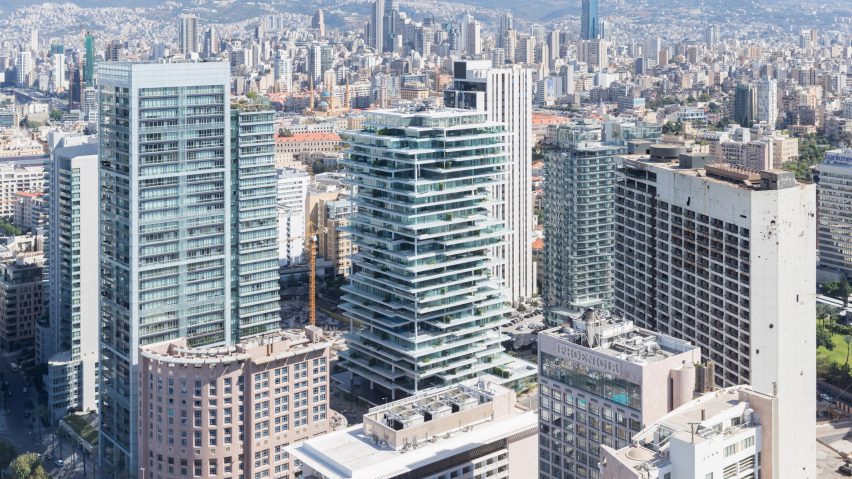Staggered floor plates and set-back glazing create large planted terraces around this 119-metre tower by Swiss architects Herzog & de Meuron, which overlooks Beirut's marina.
Jacques Herzog and Pierre de Meuron designed Beirut Terraces as part of a new masterplan developing around the St Georges Hotel. This area of the Lebanese capital is gradually being regenerated following a devastating car bomb attack that killed prime minister Rafik Hariri in 2005.
The residential tower is made up of irregularly sized floor slabs that give it an indefinite outline, not dissimilar to the firm's Jenga-like 56 Leonard skyscraper in New York.
Five modular floors are repeated in different combinations to create the staggered arrangement. The white slabs overhang the double-glazed walls by at least 60 centimetres to provide shade and to create terraces.
Various perforations in the overhangs expose areas of the terraces to the sun, while others are cast in shadow. White columns located in the corners of the tower support the overhangs, while glazed balustrades run around the edges.
"The design of Beirut Terraces was quite literally influenced by the layers of the city's rich and tumultuous history. The history of Beirut could hardly be more diverse; remains of Phoenician, Roman, Mamluk, Ottoman and colonial rule have shaped the city and its buildings," said the studio, which first unveiled plans for the project in 2010.
"Five principles define the project: layers and terraces, inside and outside, vegetation, views and privacy, light and identity," it added. "The result is a vertically layered building: slabs of varying sizes allow for interplay between openness and privacy that fosters flexible living between inside and outside."
Pot plants and trees add touches of greenery to the otherwise white block, which is envisioned as a vertical boulevard. The planting also serves as a screen, to ensure a degree of privacy for the glazed living areas while still permitting views out to sea.
"The moderate climate of Beirut is undoubtedly one of the city's greatest assets it makes outdoor living an integral part of Beirut's urban culture," said the architects.
"The idea of a green boulevard that connects the residential high-rise to its surroundings is taken up by the design and continued vertically both inside and outside the building," they added. "Indoor and outdoor spaces merge into each other so that the generous terraces truly become living spaces."
Apartments in a variety of scales are distributed throughout the tower, with some set over a single level and others arranged over two storeys. Each has a kitchen, walk-in wardrobe, laundry room and bedrooms for both the owners and live-in maids.
The residences are linked with the lobby and a shared viewing terrace via lifts located in the centre of the block. A spa with a pool, sauna, steam and massage rooms, and shopping facilities are along the eastern facade.
The Basel-based duo, who came in at number four on the Dezeen Hot List, recently completed the Elbphilharmonie Hamburg and is working on a revamp of Chelsea FC's London stadium.
Photography is by Iwan Baan.
Project credits:
Architecture: Herzog & de Meuron
Partners: Jacques Herzog, Pierre de Meuron, Stefan Marbach (partner in charge)
Project team: Tobias Winkelmann (Associate, project director), Ursula Hürzeler (project manager), Claudia Winkelmann (project manager), Alexandria Ålgård, Claire Clément, Dorothee Dietz, Corina Ebeling, Joris Fach, Dara Huang, Julia Jamrozik, Hamit Kaplan, Johannes Kohnle, Yusun Kwon, Christina Liao, Samuel Nelson, Kevin Peter, Yann Petter, Daniel Rabin, Susanna Rahm, Mónica Sedano, Raha Talebi, Antonia Weiss, Léonie Wenz, Thomasine Wolfensberger
Client: Benchmark Development

